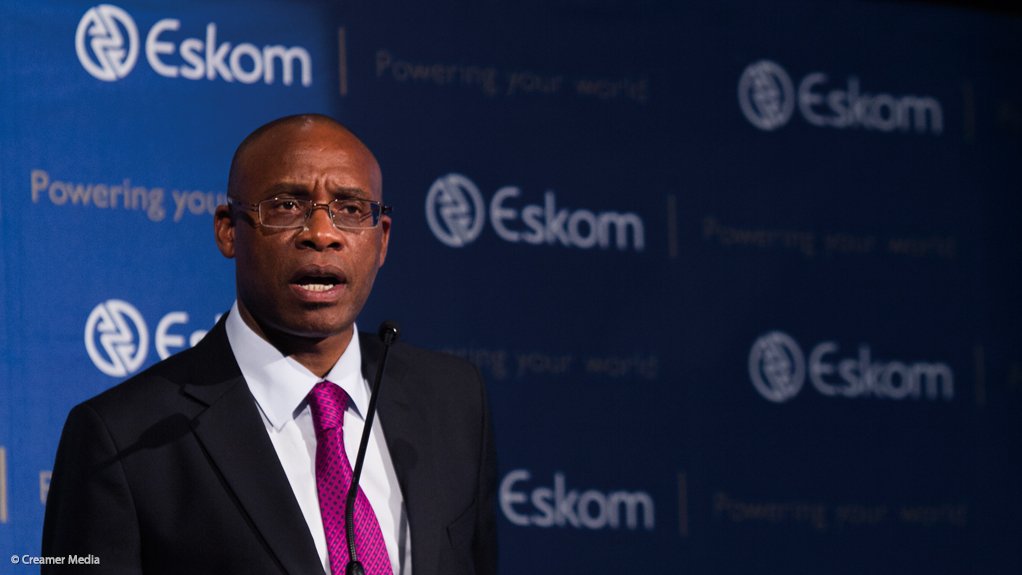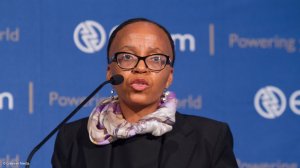State-owned electricity utility Eskom is forecasting a dramatic slump in profitability for the full-year to March 31, 2015, with CEO Tshediso Matona indicating that its profit is likely to fall to R500-million in 2014/15 from nearly R7.1-billion in 2013/14.
Releasing interim results on Tuesday, Matona indicated, too, that the group was facing serious operational headwinds that, together with its financial constraints, meant that Eskom was in it “most challenging position in living memory”.
In the six months to September 30, 2014, Eskom recorded a 5.4% rise in revenue to R82-billion period on period – a rise that was attributed entirely to higher electricity tariffs, with electricity sales falling by 1.4% to 103 494 GWh. The decline was attributed to industrial action in the platinum sector, a contraction of the gold industry and the closure of the Bayside aluminium smelter.
Revenue for the full year was expected to come in at only R146-billion and finance director Tsholofelo Molefe said sales were expected to decline materially in the second half of the financial year, while profits earned in the first half would be more or less “wiped out” in the second half.
Profit for the interim period fell to R9.3-billion from R12.2-billion when compared with the corresponding six months in the previous year, as a result of a rise in costs. Primary energy costs, comprising mostly coal and diesel, surged by 22% to R38-billion.
Costs associated with operating the diesel-fuelled open-cycle gas turbines, in the Western Cape, rose to R3.62-billion in the period, which was higher than the R3.3-billion spent in the first half of 2013/14 and also above budget.
Eskom also started receiving coal from Exxaro’s Grootegeluk mine, located alongside the Medupi project, from July. But it had been forced to make a R2.5-billion Exxaro provision, owing to the fact that it was unable to consume coal at the project, which was running behind schedule.
Municipal debt, which exceeded R7-billion, had also become a major drain on the utility, whose cash and cash equivalents declined to R12.9-billion by the end of September, from R19.7-billion at the end of March.
Equally worrying was the poor performance of the generation business, where unplanned outages increased. The energy availability factor (EAF) was recorded at 76.7% at the end of September, which was well below the group’s 80% target level.
However, the EAF was likely to deteriorate further in the second half following the November 1, 2014, coal silo collapse at the Majuba power station, which led to the first load shedding of summer on November 2 and had made the already-tight system increasingly vulnerable.
Matona indicated that the Majuba event had thrown the summer plan into “crisis” and confirmed that any minor event, from inclement weather to equipment failure, could push the system over the edge. This was partly owing to the fact that Eskom had resolved not to deviate from its planned maintenance schedule and partly as a result of high levels of unplanned outages.
“We will be under pressure and we cannot guarantee that there won’t be load shedding,” Matona, who took over as CEO on October 1, said. He was previously the director-general at Department of Public Enterprises, having led the Department of Trade and Industry prior to his tenure there.
He warned that, absent something "miraculous happening", South Africa would be "living on the edge" until new generation was introduced and the performance of the existing plant was stabilised. "It's not going to happen overnight," Matona warned, adding that it could "get worse before it gets better".
BAIL-OUT NOT ENOUGH
The financial bail-out announced by Finance Minister Nhlanhla Nene in October would help stabilise the group in the near-term, with Matona indicating that about R23-billion in equity would flow into the group in tranches during the 2015/16 financial year.
However, this support would be insufficient to guarantee the group’s longer-term sustainability and would need to be supplemented by an accelerated transition to “cost-reflective tariffs”.
In what was the strongest indication yet that Eskom might approach the National Energy Regulator of South Africa (Nersa) for a tariff reopener, Matona said there was “also an agreement with government that the tariff will need to be reviewed”.
Using the Regulatory Clearing Account (RCA) administered by Nersa, Eskom had already clawed back R7.8-billion for the second multiyear price determination period (MYPD2). This meant that the tariff would rise by 12.7% from April 1, 2015, instead of the 8% originally sanctioned.
Matona anticipated further RCA claw-backs relating to the MYPD3 determination, which granted Eskom five yearly increases of 8% from April 1, 2013, to March 31, 2018. The utility applied for yearly increases of 16%.
“The fundamental point remains that, although this package will assist Eskom’s cash flows in the short to medium term, the long-term sustainability of Eskom will still be challenged and will require that the issue of cost reflectivity in the tariff be addressed decisively. It’s a matter that is clear to everybody . . . that until we have a cost-reflective tariff, Eskom will remain financially challenged,” Matona said.
Molefe indicated that the utility still needed to model the impact of the government support package and was, thus, not yet in a position to offer an update on the anticipated revenue shortfall for the MYPD3 period, which was initially set at R225-billion.
EMAIL THIS ARTICLE SAVE THIS ARTICLE
To subscribe email subscriptions@creamermedia.co.za or click here
To advertise email advertising@creamermedia.co.za or click here













